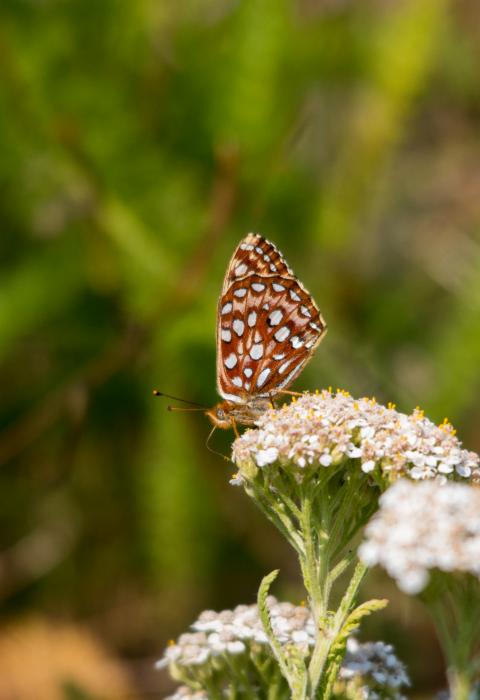PORTLAND, OR – Imagine walking through an open meadow along the Oregon coastline and you are surrounded by butterflies with wings of yellow-orange fluttering all around you. This enchanting scene is closer to becoming a reality as the U.S. Fish and Wildlife Service and partners are moving forward with plans for re-establishing two populations of the threatened Oregon silverspot butterfly.
The locations identified for potential reintroduction, both within the butterfly’s historical range, are Saddle Mountain State Natural Area in central Clatsop County and the Nestucca Bay National Wildlife Refuge in southern Tillamook County. Saddle Mountain State Natural Area, owned and managed by the Oregon State Parks and Recreation Department, has high numbers of nectar and violet plants and should be to the butterfly’s liking. Nestucca Bay National Wildlife Refuge has been actively restoring habitat for silverspots in preparation for their return.
“The collaborative work by several partnering conservation organizations to restore the butterfly’s habitat at Nestucca Bay National Wildlife Refuge began back in 2010,” Oregon Coast National Wildlife Refuge Complex Project Leader Kelly Moroney said. “I’m excited to see all the hard work of those involved in restoring the coastal prairie habitat coming to fruition with the reintroduction of the butterfly in the early part of next year. It’s extremely rewarding to be a part of this effort to bring back a native species to its coastal ecosystem on our refuge.”
The Service’s National Wildlife Refuge System plays an essential role in helping protect and conserve our nation’s most at risk species, including recent local conservation successes with the greater sage-grouse, Columbian white-tailed deer and Oregon chub.
At one time, the Oregon silverspot butterfly was widespread among 20 distinct locations from northern California to southern Washington. Only five populations currently remain, four in Oregon and one in California. The species gained Endangered Species Act protections in 1980 when it was listed as threatened. More recently, concern for the species has increased due to dramatic declines observed in 2014 and 2015 at all four existing Oregon sites. The Service is working with our partners at the Oregon and Woodland Park Zoos, the Oregon Parks and Recreation Department, and the U.S. Forest Service to reverse this trend, including this effort to reintroduce new populations.
To increase the likelihood of success, the U.S. Fish and Wildlife Service is proposing to designate these populations as experimental to provide surrounding landowners with assurances the reintroductions will not impose economic or regulatory restrictions on their properties.
“If we can successfully establish two additional self-sustaining populations of Oregon silverspot butterflies, it will contribute greatly toward meeting the recovery goal of 10 populations in six distinct areas” said Paul Henson, the Service’s Oregon State Supervisor. “By designating the new populations as experimental, we can alleviate concerns of adjacent landowners apprehensive about having an endangered species on their land, thereby encouraging conservation.”
The Service is partnering with the Oregon Zoo and Seattle’s Woodland Park Zoo, which are providing Oregon silverspot pupae for the reintroductions through their imperiled species recovery programs. Each year, a small number of female butterflies are collected from the wild and brought to zoo conservation labs, where they lay large numbers of eggs. The eggs hatch into tiny larvae, which are kept safe over the winter and released the following year to augment wild silverspot populations. These programs substantially increase the number of offspring surviving to adulthood.
“We are honored to be able to play a key role in recovering this species from the brink of extinction,” said Dr. Don Moore, Oregon Zoo director. “Pollinators like butterflies are vital for ecosystem health and, ultimately, for our own health.”
The primary limiting factor for the Oregon silverspot is lack of its caterpillar host plant, the early blue violet. The butterfly needs these violets to be densely-packed and in high numbers, surrounded by other native nectar plants. This type of coastal prairie habitat was historically maintained by regular natural disturbances such as fire, but now it is very rare naturally and often must be created and managed for it to be sustained, mostly due to invasive species invasive species
An invasive species is any plant or animal that has spread or been introduced into a new area where they are, or could, cause harm to the environment, economy, or human, animal, or plant health. Their unwelcome presence can destroy ecosystems and cost millions of dollars.
Learn more about invasive species .
The proposed rule will be published in the Federal Register on December 23, 2016. The proposal and instructions on how to provide comments can be found at www.fws.gov/oregonfwo/. Comments will be accepted through February 21, 2017.


